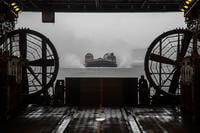Boeing's Phantom Ray stealthy UAV demonstrator made its first flight last week out of Edwards Air Force Base. The fighter-size Phantom Ray is derived from Boeing's unsuccessful X-45 bid for the Navy's unmanned combat air system demonstrator program. Boeing engineers were undaunted and decided to tweak the X-45 design and continue developing the bird on the company's own dime.
The plane made its premiere flight out of Edwards Air Force Base in California on April 27, when it flew to 7,500 feet and reached a speed of 178 knots. This flight along with upcoming ones was to prove that the plane is airworthy, engineers will gradually push the plane higher and faster and have it perform more complex manuvers to ensure that it works as designed. Once this is done, Boeing will start testing the plane's ability to do everything from conduct ISR and close air support missions to electronic warfare and autonomous mid-air refueling. Keep in mind that this is the second airplane designed to do these things that's already in flight test. Northrop's X-47, the victor in the UCAS contest, entered flight test earlier this year and will be flying off carrier decks in the coming years.
Boeing's Phantom Ray program manager said it best when he described how stealthy, unmanned combat drones are here, in a big way.
"The first flight moves us farther into the next phase of unmanned aircraft," said Craig Brown, Phantom Ray program manager for Boeing. "Autonomous, fighter-sized unmanned aircraft are real, and the UAS bar has been raised. Now I’m eager to see how high that bar will go."
Now that the flood gates are open, we may see these highly advanced UAVs make their combat debut much quicker than we expected. Heck, the Air Force is already flying one stealthy-looking UAV in Afghanistan. Some even speculate that it played a role in the mission that killed Osama bin Laden on Sunday. If they've got that bird flying publicly, I guarantee you they've got a host of similar yet more advanced projects flying in the black world.








